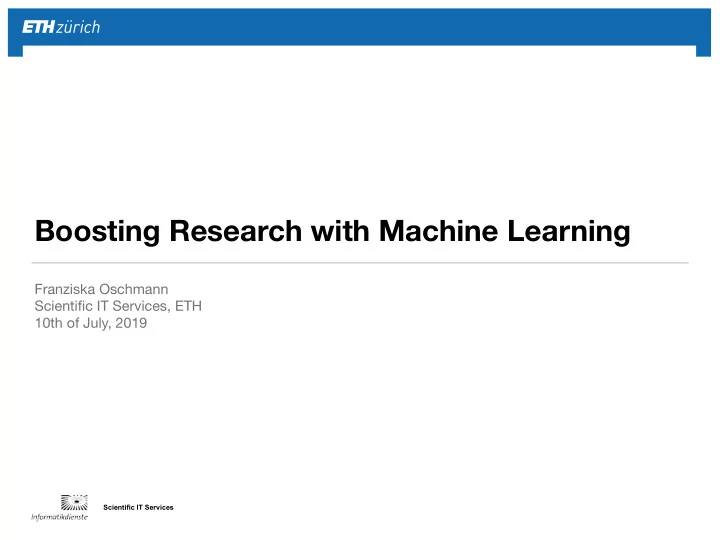

Boosting Research with Machine Learning Franziska Oschmann Scientific IT Services, ETH 10th of July, 2019 Scientific IT Services
Examples for ML in research
Examples for ML in research Discovery and characterisation of new particles https://home.cern/
Examples for ML in research Prediction of epileptic seizures https://medicalxpress.com
Examples for ML in research Characterisation of cancer regions https://camelyon16.grand-challenge.org
Examples for ML in research
Examples for ML in research Applications of ML in research: • Uncover hidden patterns in data • Automatisation of time- consuming processes
Examples for ML in research Applications of ML in research: • Uncover hidden patterns in data • Automatisation of time- consuming processes
How to apply ML in research?
How to apply ML in research? Prediction Preprocessing Model Data 1 0 scikit-learn 0 scipy Y 0 x 1 0 pandas . . . keras
How to apply ML in research? from sklearn.model_selection import train_test_split from sklearn.linear_model import LogisticRegression from sklearn.metrics import accuracy_score from my_helper import data, preprocess ## Load data Data X = data.data y = data.target ## Preprocessing of data X_proc = preprocess(X) Preprocessing ## Split into training and validation set X_train, X_val, y_train, y_val = train_test_split( X_stand, y, test_size=0.33) ## Model lr = LogisticRegression() Model lr.fit(X_train, y_train) y_pred = lr.predict(X_val) Prediction print (accuracy_score(y_val, y_pred))
Use case 1: EEG signal detection
Use case 1: Experimental setup Experimental setup Hand movement Luciw et al., Nature, 2014
Use case 1: Preprocessing Recording Recording
Use case 1: Preprocessing Recording Recording
Use case 1: Preprocessing Recording Sliding window
Use case 1: Preprocessing Recording Sliding window
Use case 1: Preprocessing Sliding window Low-pass filter
Use case 1: Preprocessing Low-pass filter Power
Use case 1: Preprocessing Low-pass filter Average Power
Use case 1: Model lda = LDA() rf = RandomForestClassifier(class_weight = 'balanced') Model lr = LogisticRegression(class_weight = 'balanced') eclf = VotingClassifier(estimators=[('lda', lda), ('rf', rf), ('lr', lr)], voting = 'soft', weights=[1,1,1]) eclf.fit(X_train, y_train) Prediction y_pred = eclf.predict(X_test)
Use case 1: Prediction observed event predicted event confusion matrix • 70% of the events were Predicted: Predicted: No Yes correctly predicted Actual: 456263 113 No • hardly any false alarm Actual: 3833 9016 Yes
Use case 1: Prediction observed event predicted event confusion matrix • 70% of the events were Predicted: Predicted: No Yes correctly predicted Actual: 456263 113 No • hardly any false alarm Actual: 3833 9016 Yes
Use case 1: Summary Classic ML model provides: • a reasonably good prediction • deeper insight into data due to interpretable models • computational low costs (training: ~30m on single CPU)
Use case 2: Segmentation
Use case 2: Data Automatic Raw image Segmentation detection ? done by hand Data acquired by: Graham Knott and Marco Cantoni at EPFL
Use case 2: Model Neural Network Implementation from keras.models import Model from keras.layers import Input, Dense inp = Input(shape=(3,)) Input Hidden hidden_1 = Dense(4)(inp) layer 1 Hidden hidden_2 = Dense(4)(hidden_1) layer 2 Output outp = Dense(1)(hidden_2) model = Model(inputs=inp, outputs=outp)
Use case 2: Model Implementation U-Net from my_models import unet model = unet() model.fit(X_train, y_train) results = model.predict(X_test) Downstream branch : ‘what’-information • Upstream branch : ‘where’-information • Ronneberger et al, MICCAI 2015
Use case 2: Prediction Raw image Ground truth Prediction
Use case 2: Summary Deep learning model provides: • automatisation of time-consuming process • recognition of patterns in complex dataset • no interpretability of model • computationally heavy solution (Training: ~2h runtime on single GPU/~2d on single CPU)
Summary Machine Learning in research: • uncover hidden patterns in data • interpretable models allow further insight • automatisation of time-consuming processes
Thank you for your attention!
Recommend
More recommend